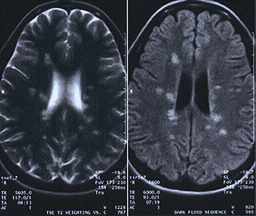
MRI FLAIR sequence showing four bright spots (plaques) where multiple sclerosis has damaged myelin in the brain. |
What Is Multiple Sclerosis? Symptoms Symptoms can come and go with no definite pattern and may vary widely from one person to the next. Some may become more or less permanent. The most common first symptoms are fatigue and confusion. Symptoms may include any of the following:
What causes MS? The specific causes of MS have been debated within the scientific community, however, Dr. Swank's 35 plus years of research show that the main causes are diet and lifestyle. His studies in different regions of Norway showed that there were far more instances of MS in those regions that ate more animal and butter fats (saturated fats) and far fewer instances in those regions that ate more oils from plants and fish (unsaturated fats). (See pg.5 of his book, The Multiple Sclerosis Diet Book) Most of Dr. Swanks MS patients also had a lifestyle that included an overload of stress. Although some studies indicate that MS may be hereditary, it is important to remember that diet and lifestyle of children is almost always also inherited from the parents. That said, it may be considered a possible additional factor. If you are concerned that your children may develop MS, the best thing you can do is improve your current situation by changing your diet and lifestyle- to give you a better quality of life that you can also pass on to your children. Categories of the Disease MS is categorized into four different courses or subtypes:
Physiological Mechanisms of MS Multiple Sclerosis (MS) is a disease of the central nervous system (CNS), which is comprised of the nerves, brain and spinal cord. What occurs is that the myelin, a fatty substance which covers the axons (nerve fibers) of nerve cells degenerates. Causing this degeneration is a process of inflammation and damage triggered by a special set of lymphocytes, (white blood cells) called T cells. The T cells gain entry into the brain via the blood-brain barrier. This barrier is not normally permeable to these types of cells unless triggered by an infection or virus, when the strength of the barrier is decreased. When the barrier regains its integrity, (usually after the infection or virus has cleared), the T cells are trapped inside the brain. These cells recognize myelin as a foreign substance and attack it as if it were an invading virus. These attacks trigger inflammatory processes. Leaks form in the barrier, which in turn cause a number of other damaging effects such as swelling, and activation of destructive proteins. The body’s repair process, called re-myelination, takes place in the early phases of the disease, but the repaired myelin sheath is not as strong and effective as the original. Repeated attacks cause a scar-like plaque to build up around the damaged axons. The axons themselves can also be damaged by the attacks. Although the brain can compensate for some of this damage, multiple attacks cause cumulative lesions or scar-like damage. “Lesions” in French is “Sclerosis”, thus “Multiple Sclerosis”. It is believed MS symptoms develop as the result of multiple lesions in the brain and spinal cord. Symptoms can vary greatly between different individuals depending on where lesions occur. More information on MS For more detailed information and research, view our Resources page (link) for links to some excellent sites. |

